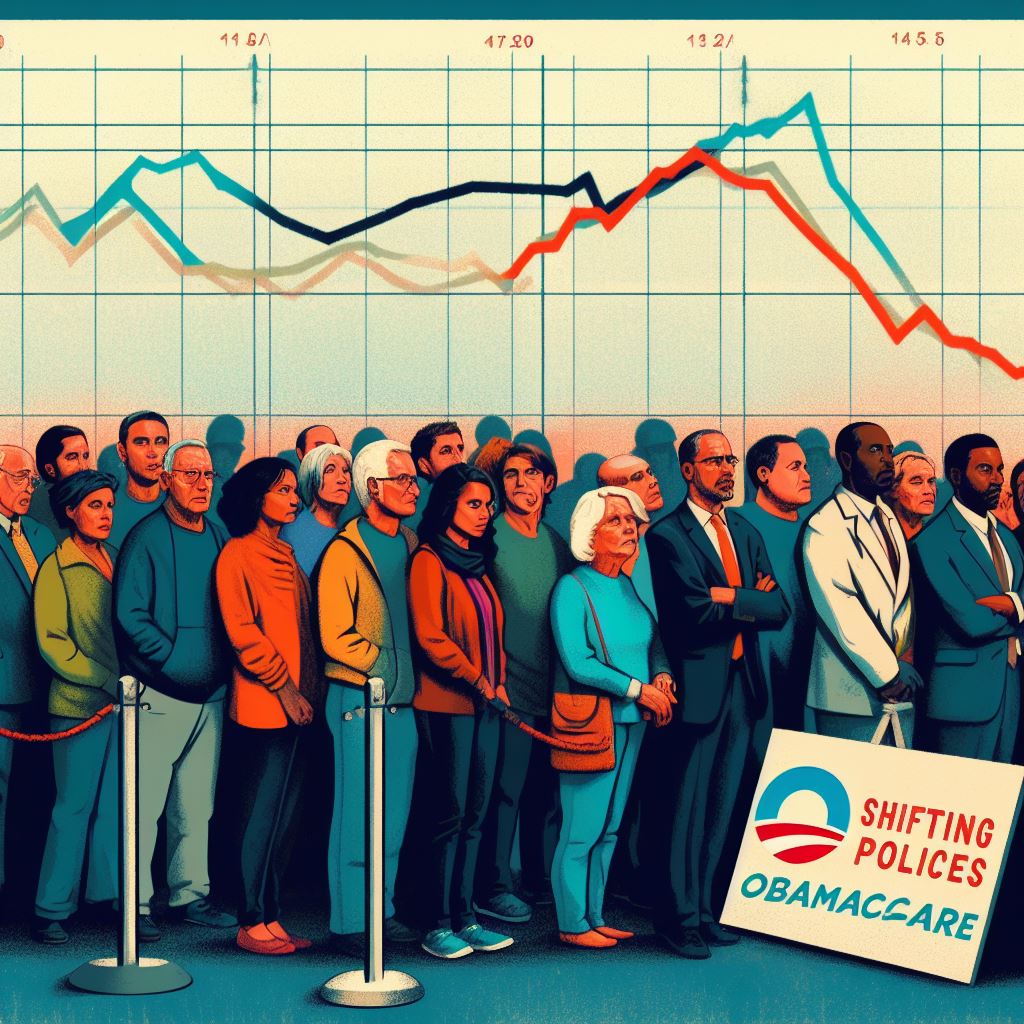Policy Shifts and Their Effect on Obamacare Enrollment

Are you curious about how recent policy shifts have impacted Obamacare enrollment? Look no further! In this article, we will delve into the effects of various changes on the enrollment process.
From the initial implementation challenges to the expansion of Medicaid eligibility, and even the repeal of the individual mandate, we will analyze the impact of these policy shifts on enrollment periods and subsidy adjustments.
Get ready to uncover the objective evidence behind the evolving landscape of Obamacare enrollment.
Key Takeaways
- Technical glitches on healthcare.gov and resistance from some states hindered enrollment in Obamacare.
- The expansion of Medicaid eligibility under the ACA led to a significant increase in enrollment and reduced the number of uninsured individuals.
- The repeal of the individual mandate in 2019 had implications for Obamacare enrollment, with concerns raised about the stability and affordability of the marketplace.
- Changes to enrollment periods, including the extension of the open enrollment period and the availability of special enrollment periods, aim to provide individuals with more flexibility and options for securing affordable healthcare.
Initial Implementation Challenges
In the article, we’ll explore the initial implementation challenges faced by Obamacare.
When the Affordable Care Act (ACA), commonly known as Obamacare, was first introduced, it faced several significant challenges.
One of the main obstacles was the technical glitches experienced by the healthcare.gov website, which hindered individuals from enrolling in health insurance plans. The website’s poor performance resulted in frustration and confusion among potential enrollees.
Another challenge was the resistance faced from some states, particularly those with conservative leadership, who were reluctant to expand Medicaid coverage as mandated by the ACA. This resistance led to a fragmented implementation of the law across different states, creating disparities in access to healthcare.
Additionally, the complexity of the ACA’s regulations and requirements posed a challenge for both consumers and healthcare providers. Understanding the eligibility criteria and navigating the enrollment process proved to be difficult for many individuals.
Moreover, the introduction of new insurance plans and the cancellation of existing plans caused disruption and uncertainty for some individuals.
These initial implementation challenges highlighted the need for improvements and adjustments in the rollout of Obamacare.
Expansion of Medicaid Eligibility
To better understand the impact of policy shifts on Obamacare enrollment, let’s delve into how the expansion of Medicaid eligibility played a crucial role in addressing the initial implementation challenges.
The expansion of Medicaid eligibility was one of the key provisions of the Affordable Care Act (ACA) that aimed to provide healthcare coverage to low-income individuals and families. Under the expansion, states had the option to increase their Medicaid eligibility criteria to cover individuals with incomes up to 138% of the federal poverty level.
The expansion of Medicaid eligibility had a significant impact on Obamacare enrollment. It allowed millions of uninsured individuals who were previously ineligible for Medicaid to gain access to affordable healthcare coverage. According to a study conducted by the Kaiser Family Foundation, states that expanded their Medicaid programs saw a significant increase in enrollment compared to states that didn’t expand. This increase in enrollment helped to reduce the number of uninsured individuals and improve access to healthcare services.
Furthermore, the expansion of Medicaid eligibility also helped to address some of the initial implementation challenges of Obamacare. By providing coverage to low-income individuals, it helped to alleviate the strain on the healthcare system and reduce the burden on emergency departments. It also helped to improve overall health outcomes by ensuring that individuals had access to preventive care and early intervention services.
Individual Mandate Repeal
You may have noticed a significant policy shift with the repeal of the individual mandate in relation to Obamacare enrollment. The individual mandate, a core provision of the Affordable Care Act (ACA), required individuals to have health insurance or pay a penalty. Its repeal, which took effect in 2019, has had implications for the enrollment numbers in Obamacare.
The individual mandate was intended to incentivize healthier individuals to purchase insurance, thereby balancing out the risk pool and keeping premiums more affordable for everyone. Without this mandate, experts predicted that healthier individuals might choose not to enroll, leading to an increase in premiums for those who remain in the marketplace.
Several studies have examined the impact of the individual mandate repeal on Obamacare enrollment. A study by the Urban Institute projected that the repeal would result in 6.4 million fewer people with coverage in the individual market by 2019. Another study by the Congressional Budget Office estimated that the repeal would lead to 13 million fewer individuals having insurance coverage by 2027.
While it’s still too early to fully assess the long-term effects of the individual mandate repeal on Obamacare enrollment, early indications suggest that the number of uninsured individuals may increase. This shift in policy has raised concerns about the stability and affordability of the ACA marketplace, and policymakers continue to debate the best approach to ensure access to affordable healthcare for all Americans.
Changes to Enrollment Periods
After the repeal of the individual mandate, there have been significant changes to the enrollment periods for Obamacare. These changes aim to provide individuals with more flexibility and options when it comes to obtaining health insurance coverage.
Here are three important changes to enrollment periods:
- Open Enrollment Period: The open enrollment period is the main period during which individuals can enroll in or make changes to their Obamacare coverage. Previously, this period ran from November 1st to December 15th. However, starting in 2022, the open enrollment period has been extended to run from November 1st to January 15th, giving individuals an additional month to enroll or switch plans.
- Special Enrollment Periods: In addition to the open enrollment period, individuals may qualify for special enrollment periods (SEPs). SEPs are triggered by certain life events, such as getting married, having a baby, or losing other health coverage. These periods allow individuals to enroll in or make changes to their coverage outside of the regular open enrollment period.
- Medicaid and CHIP Enrollment: Medicaid and the Children’s Health Insurance Program (CHIP) have year-round enrollment. This means that individuals eligible for these programs can enroll at any time, regardless of the open enrollment period.
These changes to the enrollment periods aim to make it easier for individuals to access and obtain health insurance coverage, ensuring that more people have the opportunity to secure affordable and comprehensive healthcare.
Impact of Subsidy Adjustments
The recent subsidy adjustments have significantly affected your ability to afford health insurance coverage under Obamacare. These adjustments, implemented as part of policy shifts in recent years, have had a direct impact on the affordability of health insurance plans for individuals and families.
Under the Affordable Care Act (ACA), subsidies were provided to help lower-income individuals and families pay for their health insurance premiums. These subsidies were based on a person’s income and the cost of insurance in their area. However, changes to these subsidies have resulted in higher premiums for many individuals.
One major change to the subsidy structure was the repeal of the individual mandate penalty, which required individuals to have health insurance or pay a penalty. Without this penalty, healthier individuals may choose to forgo insurance, resulting in a smaller pool of insured individuals and potentially higher premiums for those who remain insured.
Additionally, the Trump administration shortened the open enrollment period for health insurance plans, giving individuals less time to sign up and potentially limiting their access to subsidies. This change, coupled with the elimination of cost-sharing reduction payments to insurers, has led to higher premiums for many consumers.
The impact of these subsidy adjustments on affordability is evident in the decreasing enrollment numbers for Obamacare plans. According to the Centers for Medicare and Medicaid Services, enrollment in the federal exchange decreased by nearly 2 million people between 2017 and 2018.
Frequently Asked Questions
How Does the Policy Shift Impact the Quality of Healthcare Services Under Obamacare?
The policy shift impacts the quality of healthcare services under Obamacare. It is important to analyze the specific changes and their direct effects on access, affordability, and patient outcomes to understand the overall impact.
What Are the Potential Long-Term Economic Consequences of the Changes to Enrollment Periods?
The potential long-term economic consequences of changes to enrollment periods include decreased revenue for insurance companies, increased healthcare costs for individuals, and potential instability in the insurance market.
How Do the New Subsidy Adjustments Affect the Affordability of Health Insurance for Low-Income Individuals?
The new subsidy adjustments may impact the affordability of health insurance for low-income individuals. It is important to analyze the specific changes and their potential effects on the cost of insurance premiums and out-of-pocket expenses.
Can the Expansion of Medicaid Eligibility Lead to an Increase in Healthcare Provider Shortages?
Expanding Medicaid eligibility can exacerbate healthcare provider shortages. As more people gain access to healthcare, the demand for services increases, putting a strain on already limited resources. This can lead to longer wait times and decreased access to care.
What Are the Potential Effects of the Individual Mandate Repeal on the Stability of the Health Insurance Market?
The potential effects of the individual mandate repeal on the stability of the health insurance market include increased premiums, fewer healthy individuals enrolling, and potential market destabilization.



